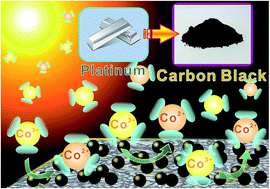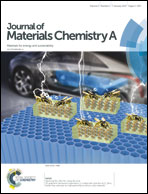Highly electrocatalytic counter electrodes based on carbon black for cobalt(iii)/(ii)-mediated dye-sensitized solar cells†
Abstract
While carbon black (CB) is an ordinary, commercial and low-cost carbonaceous material, it displays great potential as an alternative to noble metals and conductive polymers in terms of a counter electrode catalyst for dye-sensitized solar cells (DSSCs) using a Co(bpy)32+/3+ (bpy = 2,2′-bipyridine) redox couple. First, the electrocatalytic activity of this low crystalline material in relation to the cobalt-based redox reaction is carefully studied. The experimental results show that both the heat treatment and the amount of CB loading are key parameters affecting the electrochemical behavior of the resultant CB thin films. A well-prepared CB thin film exhibits better electrocatalysis than sputtered platinum does. This CB film demonstrates its ability to replace common platinum as an efficient counter electrode in DSSCs using a Co(bpy)32+/3+ electrolyte. This material is even more suitable than platinum for fabrication of semitransparent counter electrodes for bifacial photovoltaic applications. Most importantly, a highly efficient Y123-sensitized solar cell is assembled using a CB thin film, revealing a power conversion efficiency of 8.81% without any striking mass transport obstruction. The feasibility of this cost-effective CB material for utilization in DSSCs is definitely verified.


 Please wait while we load your content...
Please wait while we load your content...